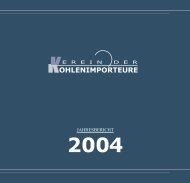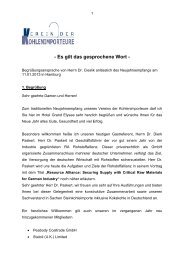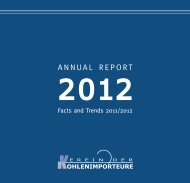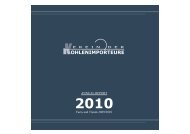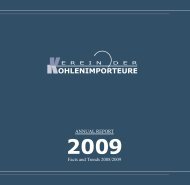Annual Report 2010 - Verein der Kohlenimporteure eV
Annual Report 2010 - Verein der Kohlenimporteure eV
Annual Report 2010 - Verein der Kohlenimporteure eV
Create successful ePaper yourself
Turn your PDF publications into a flip-book with our unique Google optimized e-Paper software.
therefore has the potential to increase its exports to<br />
Europe in 2011. Venezuela will remain a constrained<br />
supplier in terms of volume for the foreseeable future.<br />
Coking Coal Market – Signs Remain<br />
“Bullish”<br />
Demand<br />
The positive trend in the steel sector continued during<br />
the first months of 2011. All steel-producing countries<br />
have increased their pig iron production. The increased<br />
demand for coking coal has already led to price<br />
increases. As especially China and increasingly India<br />
are continuing to raise their steel production, largely<br />
based on pig iron, and OECD countries produce more,<br />
the coking coal market in 2011 could grow by 10-12%<br />
or 25-30 million tonnes compared with <strong>2010</strong>.<br />
Supply<br />
In addition to the traditional supply sources, the first<br />
deliveries from the Elgen project in Russia and from<br />
the Vale project in Mozambique could occur in 2011<br />
and extend the pool of suppliers in 2011. The high price<br />
level is also likely to encourage the expansion of coking<br />
coal mines around the world, while new coking coal<br />
projects are being examined in Indonesia, Mongolia and<br />
Colombia. Mozambique could begin exporting from<br />
the Moatize pit in 2011; it is un<strong>der</strong> construction and has<br />
been designed for a production of 11 million tonnes per<br />
annum, of which 8.5 million tonnes is coking coal and<br />
2.5 million tonnes steam coal.<br />
Australia, the USA and Canada continue to be the major<br />
suppliers to the global market. They will presumably<br />
continue to increase production and exports in 2011<br />
and in the following years. Russia, Colombia and<br />
New Zealand supply smaller quantities of coking coal.<br />
Indonesia, Venezuela, Vietnam and South Africa supply<br />
PCI coal.<br />
Infrastructure for International Coal Trade<br />
Owing to the rapid growth in recent years of the bulk<br />
commodity trade as a whole, and of coal trade in<br />
particular, infrastructure constraints have occurred.<br />
There have been major bottlenecks, sometimes serious,<br />
at both loading and discharge ports, on domestic railway<br />
lines and in sea transport. The chance to exploit market<br />
opportunities due to a rising demand for coal triggered<br />
over the last 2-3 years a worldwide infrastructure<br />
expansion, even though it came late, across all links<br />
in the transport chain. Expansion projects along the<br />
entire “coal chain” have been launched by almost all<br />
of the major countries involved in international coal<br />
trade. The problems have differed from one country to<br />
another. In Australia, for example, the primary problem<br />
is bottlenecks in port and railway capacities, while in<br />
South Africa it is limited rail capacity, already resulting<br />
today in the port of Richards Bay using only two-thirds<br />
of its capacity.<br />
The realisation of the many expansion measures would<br />
have significantly improved the situation, above all in<br />
Australia if there had been no floods at the beginning<br />
of 2011.<br />
Bottlenecks in supply are to be expected in 2011<br />
because of the production shortfalls over several<br />
months in Australia and against the background of a<br />
rising demand for coking coal, which will affect prices<br />
accordingly. If the USA covers additional demand as a<br />
“swing supplier”, then shipping capacity could rapidly<br />
reach its limit at US export ports.<br />
In Indonesia, Colombia, Russia and South Africa,<br />
many port expansion projects are in progress or already<br />
completed.<br />
63



